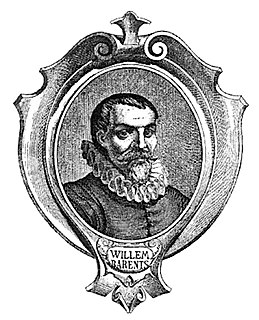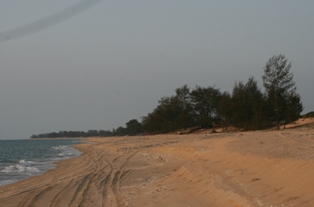
Willem Barentsz, anglicized as William Barents or Barentz, was a Dutch navigator, cartographer, and Arctic explorer.
Toponymy, also toponymics or toponomastics is the study of toponyms, their origins and meanings, use and typology. In a more specific sense, the term toponymy refers to an inventory of toponyms, while the discipline researching such names is referred to as toponymics or toponomastics. Toponymy is a branch of onomastics, the study of proper names of all kinds. A person who studies toponymy is called toponymist. Toponym is the general term for a proper name of any geographical feature, and full scope of the term also includes proper names of all cosmographical features.

Willem Hesselsz de Vlamingh was a Dutch sea captain who explored the central west coast of New Holland (Australia) in the late 17th century, where he landed in what is now Perth on the Swan River. The mission proved fruitless, but he charted parts of the continent's western coast.

Willem Cornelisz Schouten was a Dutch navigator for the Dutch East India Company. He was the first to sail the Cape Horn route to the Pacific Ocean.
Willem Janszoon, sometimes abbreviated to Willem Jansz., was a Dutch navigator and colonial governor. Janszoon served in the Dutch East Indies in the periods 1603–1611 and 1612–1616, including as governor of Fort Henricus on the island of Solor. He is the first European known to have seen the coast of Australia during his voyage of 1605–1606.

The Laguna Copperplate Inscription is an official document, more precisely an acquittance, inscribed in the Shaka year 822. It is the earliest known calendar-dated document used within the Philippine Islands.
Jan Carstenszoon or more commonly Jan Carstensz was a 17th-century Dutch explorer. In 1623, Carstenszoon was commissioned by the Dutch East India Company to lead an expedition to the southern coast of New Guinea and beyond, to follow up the reports of land sighted further south in the 1606 voyages of Willem Janszoon in the Duyfken.

Willem II, also known as Willem II Tilburg, is a Dutch football club based in Tilburg, Netherlands, whose team plays in the Eredivisie, the top tier in Dutch football. The club was founded on 12 August 1896 as Tilburgia. On 12 January 1898, the club was renamed Willem II after Dutch king William II of the Netherlands, who, as Prince of Orange and commander of the Dutch army, had his military headquarters in Tilburg during the Belgian uprising of 1830, spent much time in the city after becoming king, and died there.
The Eendracht was an early 17th Century Dutch wooden-hulled 700 tonne East Indiaman, launched in 1615 in the service of the Dutch East India Company (VOC). Its Dutch name means "concord", "unity" or "union", and was a common name given to Dutch ships of the period, from the motto of the Republic: Concordia res parvae crescunt. The ship was captained by Dirk Hartog when he made the second recorded landfall by a European on Australian soil, in 1616.

Meursault is a commune in the Côte-d'Or department and region of Bourgogne-Franche-Comté in eastern France.

The Pennefather River is a river located on the western Cape York Peninsula in Far North Queensland, Australia.

The Caristii were a pre-Roman tribe settled in the north of the Iberian Peninsula, in what today are known as the historical territories of Biscay and Álava, in the Basque Country, northern Spain.

Willem Janszoon captained the first recorded European landing on the Australian continent in 1606, sailing from Bantam, Java, in the Duyfken. As an employee of the Dutch East India Company, Janszoon had been instructed to explore the coast of New Guinea in search of economic opportunities. He had originally arrived in the Dutch East Indies from the Netherlands in 1598, and became an officer of the VOC on its establishment in 1602.

The black swan is widely referenced in Australian culture, although the character of that importance historically diverges between the prosaic in the East and the symbolic in the West. The black swan is also of spiritual significance in the traditional histories of many Australian Aboriginal peoples across southern Australia. Metaphoric references to black swans have appeared in European culture since long before Europeans became aware of Cygnus atratus in Australia in the 18th century.

Santa Cilia is a municipality located in Jacetania, province of Huesca, Aragon, Spain. It is 14 km from the town of Jaca between the River Aragon and the national highway N-240.

Caert van't Landt van d'Eendracht is a 1627 map by Hessel Gerritsz. One of the earliest maps of Australia, it shows what little was then known of the west coast, based on a number of voyages beginning with the 1616 voyage of Dirk Hartog, when he named Eendrachtsland after his ship.

Of an estimated 200 place names the Dutch bestowed on Australian localities in the 17th century as a result of the Dutch voyages of exploration along the western, northern and southern Australian coasts, only about 35 can still be found on current maps. Five out of six names were either renamed or forgotten or their locations were lost. Other places were named after the early Dutch explorers by later British explorers or colonists, for instance the Australian state of Tasmania is named after Abel Tasman. Australia itself was called New Holland by the English and Nieuw Holland by the Dutch.
Timote, also known as Cuica or Timote–Cuica, is the language of the Timote–Cuica state in the Venezuelan Andes, around the present city of Mérida and south of Lake Maracaibo.

The Marañón River basin, at a low point in the Andes which made it an attractive location for trade between the Inca Empire and the Amazon basin, once harbored numerous languages which have been poorly attested or not attested at all. Those of the middle reaches of the river, above the Amazon basin, were replaced in historical times by Aguaruna, a Jivaroan language from the Amazon which is still spoken there. The languages further upriver are difficult to identify, due to lack of data. The region was multilingual at the time of the Conquest, and the people largely switched to Spanish rather than to Quechua, though Quechua also expanded during Colonial times.

The Lac au Goéland is a freshwater body of water crossed by the Waswanipi River and is located within Eeyou Istchee James Bay (municipality), within the administrative region of Nord-du-Québec, in the province of Quebec, in Canada.













